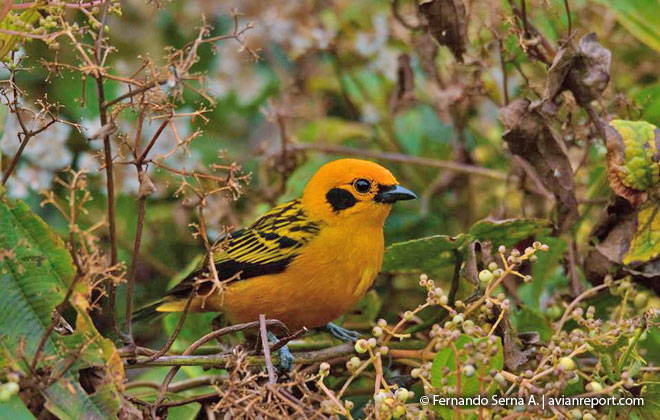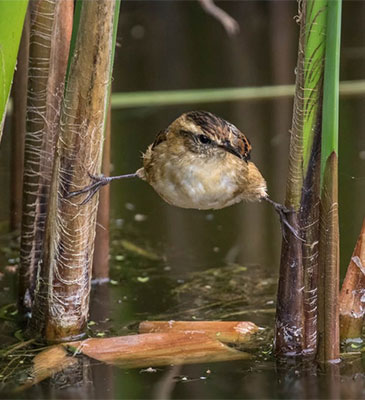Bird Habitat is the area with ecological and environmental characteristics where a species has adapted to find essential elements such as food, water, shelter, and mates for reproduction.

Are birds restricted to specific habitats?
Birds can fly and are seemingly everywhere, but they occupy specific areas (habitats) that meet all or part of these essential elements.
Ornithologists indicate that “a bird’s habitat is often a signature of its identity.” Each habitat type has a specific composition and structure to which a species is well-adapted. This adaptation comes in the shape and length of the bill, legs, wings, plumage patterns and coloration, and behavior. Going to extremes, one would not expect to see a duck searching for insects in a tree; a duck would be expected in or near water. Its feet and bill are adapted to live in the water.
Birdwatchers use habitat as a tool for bird identification. Once you learn the habitat type to which a species or group of species are associated, you will be better able to eliminate other possibilities and identify the birds you see.
Essential elements of bird habitat include:
- Food: The food a bird eats is found in the environment in many forms. Whether fruit, nectar, or invertebrates, a bird needs physical attributes and a specific behavior to obtain food efficiently.
- Water: As with other animals, water is essential to birds. Water can be superabundant at times but scarce in others. When water is scarce, birds have adapted to obtain water from the food types they eat.
- Shelter and Mates for Nesting and Reproduction: Birds have specific requirements for shelter and nesting—some birds nest in trees, shrubs, cavities, rock walls, and on the ground. The shelter is also important as protection from predators. Some birds have plumages that blend in the habitat type they use.

Bird Habitat Types
Bird habitats are classified into:
- Forest Habitats: Include areas covered mainly with trees, showing some layering and undergrowth. Recently disturbed forestland (cutover or wildfire) with no forest cover is considered a forest gap, still thought of as a type of forest habitat because it is expected to revert to forest.
- Non-forest Habitats: Includes areas covered with grass, shrubs, scrub, or a combination of several vegetation types. Generally, non-forest habitats show a single layer and, when present, a short undergrowth.
- Aquatic habitats: are areas that are permanently or seasonally covered by water. The vegetation cover varies from bare surface to grasses, reeds, rushes, scrub, or a combination of various vegetation types. Flooded forests are not considered aquatic habitats.
While all habitats offer the essential elements to birds, each habitat differs in the type and diversity of its structural elements in it. The extent to which critical features are available to a species and how important it is for such species’ life cycle or part of it defines a habitat’s quality. Suitability options are:
- Suitable habitat– Offer essential requirements for a species’ life cycle or part of it. The species occurs in the habitat regularly or frequently.
- Marginal Habitat – Offer little or hard access to essential elements of a species’ life cycle. The species occurs in the habitat only irregularly or infrequently, or only a small proportion of individuals are found in the habitat.
For some species, habitat availability throughout a year cycle is important (e.g., migratory species).
Habitats throughout an annual cycle include:
- Resident Species Habitat: used by a bird species during its entire life cycle (e.g., breeding and non-breeding)
- Breeding Habitat: is used only during the breeding season, usually separate from the habitat a bird uses during the rest of the life cycle.
- Non-breeding Habitat: Habitat used during the non-breeding season, usually separate from the habitat a bird uses during the rest of the life cycle.
- Habitat in Migration: Habitat used during migration.
A micro-habitat is a habitat with a different composition, structure, or substrate that differs from the more extensive habitat. Micro-habitats are very diverse and generally are composed of plant species or plant communities or abiotic elements, all nested within a more extensive habitat.
Habitat use by birds
The habitat that birds use is determined by indirect and direct factors.
Indirect factors are innate bird morphology and behavior that develop through an evolutionary process. A bird’s morphology and behavior enable it to find food and shelter efficiently.
Some birds have long legs and are adapted to live in grass and shallow water, while others have short legs and are adapted to arboreal life.

The shape of a bird’s bill is perhaps one of the most important adaptations to its habitat. When birds choose a habitat type, their bill shape plays a crucial role in picking up or catching, handling, and processing the type of food that is found there.
The shape of the wings is also an important adaptation. Round and broad wings are ideal for maneuvering in dense vegetation. Wings that are long and narrow would not function well inside forests or other habitats that feature dense vegetation but are ideal for soaring, gliding, and finding food in open habitats.
Photo: The Wren-like Rushbird has adapted to life in reed beds where all possible perches are oriented vertically. Photo: Shirley Freyre Mauny.
Direct factors include habitat characteristics such as vegetation structure, topography, and even the presence of other bird species influencing a bird’s habitat choice. Direct factors have to do with how habitat characteristics enable birds’ morphology and behavior to function efficiently in such a habitat.
Often, birds choose their habitats on the basis of structural characteristics and color patterns that help them avoid predation by blending into the landscape and remaining undetected by predators.
Habitat features can also influence whether birds choose to live there. For example, some birds require elevated perches to detect flying insects. In the absence of tall perches, birds that need such features to find food are unlikely to choose such habitats even when other components of the habitat are suitable.
The presence of other species may influence habitat choice
Birds may rely on other species to find food and avoid predators. There are many species of birds that join mixed-species foraging flocks, which are often led by a few species known as core members. Birds may choose habitats occupied by flocks’ core species, which congregate and lead foraging flocks. Habitats, where flocks’ core species are absent, are avoided by species that need to join flocks to forage for food efficiently and safely.
A bird may also avoid habitats occupied by species that compete for the same or similar resources. Competition for resources among birds is the leading reason why birds not only choose certain habitats but also why birds have different behavioral and morphological adaptations that allow many species to share resources at the same habitat or segregate each other to separate habitats.
LEARN MORE ABOUT BIRD BIOLOGY:





